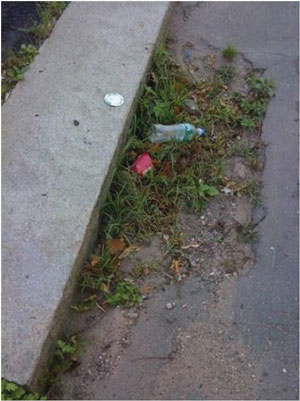The drainage problems discussed in the previous section can directly cause or contribute to crashes. As an example, drainage features that fail to remove run-off because they are too small or are clogged and pond water on the roadway can cause hydroplaning or force drivers to leave their lane. Additionally, other drainage features which do not have anything to do with causing a crash can significantly contribute to the severity of the crash, such as an errant vehicle striking a culvert headwall.
It is important to identify these potentially hazardous situations as soon as possible. Some of these conditions may have been in existence for quite some time, while others may have recently developed as a result of a storm or change in weather conditions. For areas of the country that are subject to freezing, the spring thaw frequently reveals pavement, shoulder and roadside deterioration.

Drainage problem locations can be identified in several ways:
- Citizen complaints—Citizens drive the roads every day and are the first to notice problems. You should have an easily identified phone number, e.g. on your web site, where citizens can call in problems and complaints.
- Local police—Your local police patrols can also identify drainage problems. Police personnel need to be instructed on what types of drainage problems they should be on the ‘look out’.
- Crash data—A periodic review of crash data can reveal some locations where drainage deficiencies may be a contributing factor. Locations that experience a higher than average number of wet weather crashes may have deteriorated pavement surfaces. Also look for crashes with fixed objects, which could include drainage structures that need to be removed or protected by a barrier.
- Field reviews—Potentially hazardous drainage features are best identified through field reviews. Drainage features may be reviewed alone or in a combined safety review. An excellent time to review a road or section of highway is when there is other highway work being planned. For example, if a section of road is scheduled for an overlay, the section may be reviewed to determine if there are any safety improvements that can be included. Including drainage improvements on other projects will often reduce the cost of the work and the inconvenience to the public.
FIELD INSPECTION CHECK LIST
(CHECK FOR THE FOLLOWING CONDITIONS)
1. Rutting or shoving of pavement surface.
2. Discontinuity of surface level between the pavement and shoulder (shoulder drop-off).
3. Accumulation of earth or debris on shoulder.
4. Existence of erosion channels on ditch side slopes.
5. Silt or debris accumulation in ditch.
6. Headwalls and drainage structures that are not flush with the ground.
7. Damage to drainage structures, such as crushed culverts.
8. Grates with wide openings parallel to the roadway that can trap bicyclists.
9. Drains blocked by soil and debris.
10. Side slopes that have steepened due to erosion.
11. Erosion around all roadside structures such as headwalls, sign posts, and guardrail posts.
12. Drainage structures within clear zone that are not traversable or protected by suitable barrier system.
